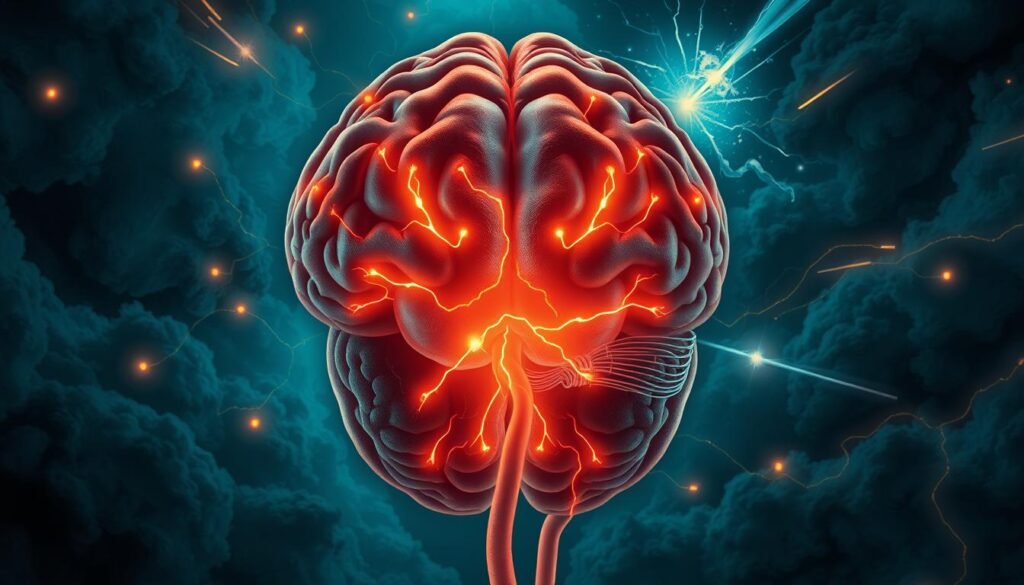Did you know about 6.8 million adults in the U.S. facing Generalized Anxiety Disorder (GAD) yearly? Anxiety disorders are very common and greatly impact our mental health. Sometimes, we hardly notice their effects. This article will shed light on the “anxiety brain” and its impact on our thinking, feelings, and overall mental wellness. By understanding how anxiety works and finding good ways to deal with it, we can improve our mental health and life.
We’ll cover how widespread anxiety disorders are, the different kinds, their symptoms, and what causes them. We’ll look into new treatments and ways to cope that can help manage mental health. As you read, you’ll find key cognitive insights important for both care providers and individuals.
Key Takeaways
- Anxiety disorders, such as GAD and social anxiety disorder, impact millions of adults every year.
- The anxiety brain alters the brain structure, affecting emotional regulation and cognitive processes.
- Individuals often wait years before seeking help for anxiety symptoms.
- Long-term anxiety can lead to serious health implications, including heart disease and digestive issues.
- Understanding the brain mechanisms involved is key to effective treatment and management strategies.
- Innovative therapies and community support can significantly enhance coping strategies for individuals with anxiety.
Understanding Anxiety: An Overview
Anxiety is a common feeling when facing stress, like during exams or job interviews. It warns us of danger but can become overwhelming. If these feelings grow too strong and last too long, it might be an anxiety disorder.
Anxiety disorders affect one’s mind and body, making daily activities hard. Symptoms include constant worry, panic attacks, or intense fears. That’s why knowing about mental health awareness is important. Conditions like generalized anxiety disorder (GAD) might last for months or years.
It’s vital to seek help for anxiety. Cognitive behavioral therapy (CBT) is a top treatment option. While some medicines help, they may take weeks to work fully. Knowing about anxiety early can lead to better handling and fewer symptoms.
For detailed information on anxiety disorders, please visit Understanding Anxiety Disorders.
What is the “Anxiety Brain”?
The term “anxiety brain” deals with how chronic anxiety changes the brain. It focuses on brain parts key to how we feel and react. Knowing about the anxiety brain sheds light on how anxiety shapes our actions, feelings, and thoughts in different situations.
Definition and Significance
The anxiety brain shows changes in activity and structure due to high anxiety. This leads to constant worry, affecting mental health deeply. Anxiety disorders are very common worldwide. The amygdala, crucial for our emotions, is heavily involved in this process.
The Role of the Amygdala
The amygdala looks like an almond and deals with fear and anxiety. It causes us to react strongly in scary situations. For example, people might freeze with fear, similar to how rats stop moving if they keep getting shocked. This shows how the amygdala helps recognize danger and manage our anxiety.
Recently, new ways to calm the amygdala have been found. One study shows that a quick light in the eye can lessen anxiety without us knowing. This 2021 research found it made people less upset by bad memories. It’s a new way of calming down our anxiety responses.
Understanding how the amygdala works with the anxiety brain helps us get why anxiety disorders happen. It also shows us new ways to treat them. This lets people handle anxiety better and find lasting solutions, not just quick fixes.
Prevalence of Anxiety Disorders
Anxiety disorders impact millions, highlighting a major mental health issue. The prevalence of anxiety shows how widespread it is, shocking many. Understanding these numbers helps raise awareness and encourages people to seek support.
Statistics on Anxiety Disorders
About 19.1% of U.S. adults have had an anxiety disorder in the last year. That’s a lot of people dealing with anxiety every day. Women experience it more, at 23.4%, compared to men at 14.3%. Plus, roughly 31.1% of U.S. adults may deal with an anxiety disorder at some point, showing its significant reach.
Gender Differences in Anxiety Disorders
Adolescents also show gender differences in anxiety rates. About 31.9% of U.S. teens might face anxiety in their lifetime. Specifically, 38.0% of girls compared to 26.1% of boys report such issues. This difference prompts questions about what drives anxiety disparities.
Anxiety leads to different levels of problems in adults. Last year, 22.8% reported severe issues, while 43.5% had mild difficulties. These figures underline the critical need for action, not just for personal health but for societal well-being too.
Types of Anxiety Disorders
Anxiety disorders come in different forms. Each type has its own symptoms and challenges. Knowing these disorders helps with the right treatment.
Panic Disorder
About 2% to 3% of U.S. adults have panic disorder. They face sudden panic attacks. This can change how they act and make them fear another attack.
Generalized Anxiety Disorder (GAD)
GAD affects roughly 2.9% of adults. It causes constant, strong worry over many life aspects. This makes everyday situations hard to handle.
Post-Traumatic Stress Disorder (PTSD)
PTSD affects around 6% of people. It happens after seeing or living through something traumatic. Symptoms include flashbacks, severe anxiety, and uncontrollable thoughts.
Social Anxiety Disorder
7% of U.S. adults struggle with social anxiety disorder. It causes fear of being judged or embarrassed in social settings. This leads to avoiding social interactions.
Obsessive-Compulsive Disorder (OCD)
Approximately 2.3% of adults have OCD. It brings unwanted thoughts and repetitive behaviors. These obsessions can upset daily life and cause a lot of stress.
Phobias
8% to 12% of adults have specific phobias. They’re very afraid of certain things or situations. This leads them to avoid things, which can change their life.

Symptoms of Anxiety and its Impact on Mental Health
Anxiety disorders are a big issue in mental health today. It’s key to know the symptoms to understand its effects on mental health. Symptoms vary widely and include physical, cognitive, and behavioral issues.
Physical Symptoms
People with anxiety may feel different physical symptoms. These include:
- Rapid heartbeat
- Trembling or shaking
- Excessive sweating
- Fatigue
- Gastrointestinal issues, such as nausea or irritable bowel syndrome
Mental Symptoms
The mental effects of anxiety are deep. People often feel scared, worried, and overwhelmed. This can hurt daily life by:
- Diminishing focus
- Increasing depression risk
- Causing short-term memory loss
Cognitive Symptoms
Cognitive issues are central to anxiety’s impact. Negative thinking and decision-making problems are common. These issues include:
- Worries about the future
- A feeling of doom
- Struggling to concentrate
Behavioral Symptoms
Behavioral signs of anxiety mean big changes in social behavior. People may pull back from social life and relationships. They often feel too stressed to interact with others. Other signs are:
- Avoiding certain places
- Sticking to routines more
- Compulsive behaviors to reduce anxiety
How Anxiety Affects Brain Chemistry
Anxiety changes brain chemistry in big ways. It messes with neurotransmitters that help us control our emotions and think clearly. If we learn more about these changes, we can find better ways to treat anxiety.
The Role of Neurotransmitters in Anxiety
Neurotransmitters like serotonin, GABA, and dopamine help regulate our mood and anxiety. When serotonin levels are low, we may feel more anxious or depressed. GABA helps calm the brain, and medicines that target GABA receptors can reduce anxiety symptoms. Dopamine also plays a role in controlling anxiety and could help lower social anxiety.
Effects on Serotonin Levels
Serotonin has a big impact on our mood and anxiety levels. Low serotonin can make us feel more anxious and sad. There are treatments that increase serotonin production and help manage anxiety. Keeping serotonin levels healthy is key for feeling emotionally strong.
Interplay Between Brain Structures
The interaction between different brain areas is crucial to understanding anxiety. For example, too much activity in the amygdala can mess up how we process emotions, causing too much fear. The prefrontal cortex helps us make decisions and control emotions, but anxiety can weaken its function. This makes it hard to handle stress and make plans.
The Cognitive Impact of Anxiety on Brain Function
Anxiety deeply affects how we think, especially by changing our brain’s pathways. When stress gets worse, our brain’s pathways get really stiff. This stiffness makes it hard to think flexibly and adjust to new things. Such reactions can cause a cycle where anxiety makes itself even worse.
Increased Rigidity of Neural Pathways
Anxiety can make our minds less open to learning and changing. When we’re stressed, our brain’s pathways don’t adjust well. Making it tough to learn new things. This stiffness stops our brains from making new links or building on positive actions. Instead, it makes negative thoughts stick.
Impact on Decision-Making and Memory
Making decisions when anxious is very hard. People find it tough to focus and remember things because anxiety takes up so much mental space. Studies show that anxiety hurts our ability to remember words and understand space. When a task needs lots of thought, anxiety makes doing well harder. It shows how much anxiety can mess with our choices and memory.
| Cognitive Function | Effect of Anxiety |
|---|---|
| Decision-Making | Reduced flexibility in choices, increased indecision |
| Memory Recall | Difficulty retrieving information, especially under stress |
| Concentration | Impaired focus, leading to diminished cognitive performance |
| Learning | Hindered ability to adapt and process new information |
Causes of Anxiety Disorders in the Brain
Understanding anxiety disorders is complex. It involves both genetic and environmental factors. How anxiety shows in people is shaped by these factors. Brain structure also plays a crucial role in anxiety development. This reveals the complex nature of anxiety disorders.
Genetic Factors and Anxiety
Genetics are key in the risk for anxiety disorders. Anxiety conditions are more common in some families, pointing to hereditary factors. For example, the gene RBFOX1 is linked to more intense anxiety reactions. Those with certain genes may react more to environmental triggers.
Environmental Triggers
Things around us can trigger or worsen anxiety. Traumatic events, big life changes, or ongoing stress can lead to anxiety. People facing these stressors often feel more anxious. Treatment that includes therapy and changes in lifestyle can help relieve anxiety symptoms. For tips on managing stress and anxiety, check out stress management strategies.
The Role of Brain Structure
Brain structure is key in understanding anxiety disorders. The amygdala and hippocampus are important for emotions and memory. The amygdala reacts to threats by creating fear, while the hippocampus helps in remembering these fears. Problems in these brain parts can cause overreactions to stress. Research using fMRI scans aims to learn how these areas work together. This could lead to new treatments, such as deep brain stimulation. Ongoing studies are crucial for creating new anxiety therapies, as discussed in this article.

Therapy Techniques for Managing Anxiety
Various effective methods are used to handle anxiety, meeting the unique needs of each person. These techniques include changing negative thoughts, practicing mindfulness, and using relaxation exercises regularly. Together, they help lessen anxiety symptoms and boost mental well-being.
Cognitive Behavioral Therapy (CBT)
CBT is vital in tackling anxiety. It helps individuals spot and change negative thoughts that pop up automatically. Such thoughts, especially worries about what’s yet to come, can fuel anxiety. Through CBT, people learn to question their beliefs and decide more wisely, leading to less anxiety.
Mindfulness Meditation
Mindfulness meditation teaches staying aware in the current moment. It’s great for handling sudden anxiety spikes. By focusing on the now, one can get in tune with their thoughts and feelings. This boosts emotional control. Regular mindfulness reduces stress and enhances concentration, making it easier to manage anxiety.
Applied Relaxation Strategies
Relaxation techniques like square breathing help calm anxiety quickly. They show people how to soothe themselves when anxious feelings hit. Using these methods often brings inner calm and builds up defense against future anxiety.
Medications for Anxiety Disorders
Many people with anxiety disorders find help with certain medications. These drugs work by changing brain chemistry to ease symptoms. Knowing the different kinds of anxiolytic (anxiety-reducing) drugs can help people get better treatment.
Types of Anxiolytic Medications
Anxiolytic drugs are key in dealing with anxiety. Below is a table that lists common types of these medicines and how they work:
| Medication Type | Examples | Mechanism of Action | Typical Onset Time |
|---|---|---|---|
| Selective Serotonin Reuptake Inhibitors (SSRIs) | Fluoxetine, Sertraline | Increases serotonin levels by blocking reabsorption | 2-6 weeks |
| Serotonin-Norepinephrine Reuptake Inhibitors (SNRIs) | Duloxetine, Venlafaxine | Reduces reabsorption of serotonin and norepinephrine | 2-6 weeks |
| Tricyclic Antidepressants (TCAs) | Amitriptyline, Clomipramine | Blocks reabsorption of serotonin and norepinephrine | Varies |
| Benzodiazepines | Xanax (alprazolam), Klonopin (clonazepam) | Enhances the effect of the neurotransmitter GABA | Immediate |
Understanding Brain Chemistry in Medication
Knowing how brain chemistry works is important for anxiety meds. SSRIs and SNRIs change serotonin and norepinephrine levels, helping to ease anxiety. Benzodiazepines work by boosting GABA’s calming effects quickly. But, they can be addictive.
These drugs are usually given for short times, like 6-12 months, as other treatments begin. Overall, there’s a wide range of meds for anxiety. Choosing the right one depends on understanding their effects on the brain. A careful choice will match people with the best treatment for their anxiety.

Coping Strategies for Managing Anxiety
To manage anxiety well, it’s key to use different coping strategies. These can really help improve how you feel overall. By focusing on self-help, staying physically healthy, and getting support from others, you can gain more control. This makes you stronger and keeps your life balanced.
Self-Help Techniques
Self-help methods are great for quick relief from anxiety. Using journaling and mindfulness meditation can be very helpful. When you journal, you write down what you think and feel, which lowers your anxiety. Mindfulness teaches your brain to deal with anxious thoughts better.
Physical Health and Wellness
Your physical health is super important in dealing with anxiety. Regular exercise, be it intense or light, reduces anxiety a lot. Eating right also matters. Include fruits, vegetables, and foods rich in omega-3s for better health. Plus, getting at least seven hours of sleep each night keeps your mind healthy.
Importance of Community Support
Having support from others is crucial when managing anxiety. It builds resilience and creates places for safe sharing. This connection helps you learn from others and fights off loneliness. Loneliness can make anxiety worse. Support groups and community help offer emotional and practical support. This shows how key relationships are in beating anxiety.
Future Avenues for Anxiety Research
The study of anxiety is changing fast, thanks to new treatments and tools. Experts are now diving deeper into what causes anxiety disorders. They’re also using tech to make therapy better and easier to get. One exciting method is using virtual reality in exposure therapy. This could change how therapy is done, making it fit better for each person.
Emerging Treatments and Innovations
New kinds of therapy are being discovered. A lot of research is looking at the brain and how it works in anxiety. For example, lacking LXRβ in female mice causes them anxiety. This discovery could lead to treatments focusing on LXRβ in the brain, helping to calm anxiety. By fixing the balance between certain brain signals, these new treatments might make therapy much more effective.
The Role of Technology in Therapy
Technology is changing how we treat anxiety disorders. Now, we can look into specific brain areas like the BNST, which was hard to study before. Thanks to better imaging, we can see how neurotransmitters work in stress. This will help create treatments that are right for each person’s brain, proving tech’s role in bettering anxiety research and treatment.
Conclusion
Understanding how anxiety works in the brain is key to knowing its big impact on mental health. It touches many lives, with over 19% of people in the US facing anxiety disorders each year. Learning about the different kinds of anxiety, what symptoms they bring, and what causes them helps people find the right treatments and feel better.
Anxiety can cause certain areas of the brain, like the amygdala, to be more active. This makes feelings of fear stronger. However, using neuroplasticity through methods like Cognitive Behavioral Therapy (CBT) can teach effective ways to deal with these feelings. Strategies include changing how we think and managing our emotions better. Adding physical activities and mindfulness to our daily routine can also make a big difference in how we feel.
Choosing coping methods that lessen anxiety, like deep breathing and relaxation, can build strength against anxiety. It’s also important to support ongoing research in this important area. As we learn more about the anxiety brain, we will find better treatments. This will lead to improved mental health for many people.